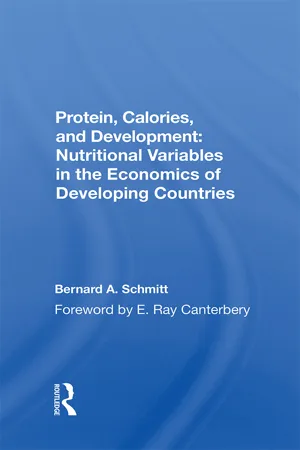
Protein, Calories, And Development
Nutritional Variables In The Economics Of Developing Countries
- 246 pages
- English
- ePUB (mobile friendly)
- Available on iOS & Android
Protein, Calories, And Development
Nutritional Variables In The Economics Of Developing Countries
About This Book
Production of world food supplies is related to more complicated socioeconomic variables than have previously been analyzed. Besides traditional inputs of land, labor, and fertilizer, the technological capabilities and a variety of nutritional and other human capital components are significant independent variables in explaining agricultural production in the developing world. The integration of economic analyses with the concepts of nutritional science offers an expanded and effective means for analyzing the complex problems of agricultural production in nutritionally deficient countries. Bernard Schmitt traces the circular relationship between nutrition and human capital, labor productivity, food production, and per capita consumption of calories and protein. He defines the basic nutritional terms that are most useful to economists in analyzing agricultural and foodrelated questions and provides examples that stress the importance of concentrating on nutritional quality as well as gross quantity. Transformations are used to convert quantities into basic nutritional components, allowing more meaningful quantitative analyses in an econometric framework. Dr. Schmitt presents a flexible methodology for forecasting commodity production, using it to make projections for the developing countries for each major commodity group and to test various policy alternatives such as extensive trade, expanded food assistance programs, substantial resource or input expansion, further expansion of Green Revolution technology, and development of alternatives to agriculture. Although he is certain that gains can be accomplished through population control and agricultural advances, supplemented by alternative nutritional sources, he concludes that conditions in nutritionally deficient countries are unlikely to improve, on average, through the mid-1980s.
Frequently asked questions
1. The Global Food Problem: Past and Present
The Nutrition Factor
The Nature of Nutritional Deficiencies
Table of contents
- Cover
- Half Title
- Series Page
- Title
- Copyright
- Contents
- List of Tables and Figures
- Foreword
- Preface
- 1. The Global Food Problem: Past and Present
- 2. Nutritional Requirements and Diet Quality
- 3. Nutrient Sources and Their Relative Importance
- 4. Production Relationships: Agricultural Commodities in the Developing Countries
- 5. Agricultural Commodity Projections, 1985: An Alternative Approach
- 6. Policy Implications of Nutrition for Developing Countries
- 7. Conclusions
- Appendixes
- Notes
- Selected Bibliography
- Index